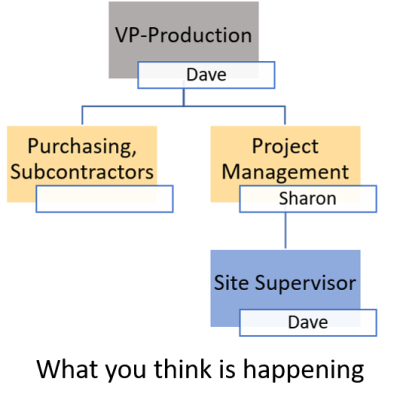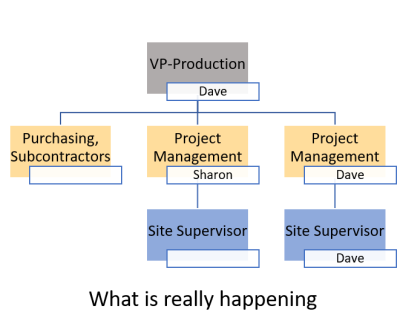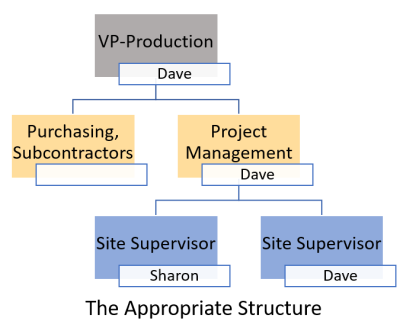Organizing for Efficiency

Here is a sample organization chart for an independent construction company

Note that the work that has to be done is grouped under specific business functions, and the accountabilities flow through the structure.
“Site Supervisor” reports to “Project Management”, who reports to “VP-Production”, who reports to “CEO”.
Note also that there are no names for the positions. Right now, the business should be focused on what tasks have to be done to deliver on your promise, your UVP (Unique Value Proposition).
When you are just starting out, YOU will probably fill every position.
That’s OK.
Later on, as the business grows, you will work yourself out of each subordinate position.

Rules for constructing an organizational chart
The purpose of a role chart is to define the accountabilities of a position, and thereby, the accountabilities of the person holding that position. The senior position should hold the subordinate position responsible for the duties inherent in that position.
Reporting = being held accountable for the performance of the duties of the position.
Any one position should not have direct control of more than five subordinate positions.
Any person holding a position can, of course, report to themselves. You can be the Brand Manager reporting to yourself as the VP-Marketing reporting to yourself as the CEO.
Outsourced = outside the company’s chain of command. Such entities are consultative in nature – attorneys, accountants, business consultants, coaches, technology experts. Outsourced entities have no power in the organization other than the value of their contribution, and should be given no authority other than the authority of the internal position which engages them.
For example, the CEO engages a Marketing Coach to review and make suggestions about the prospect conversion process. The Marketing Coach becomes the conduit between the CEO and the VP-Marketing positions relative to any additional accountabilities accruing to the VP-Marketing. The VP-Marketing is expected to work with, but is not accountable to, the Marketing Coach. Per the role chart, the VP-Marketing is accountable to the CEO only.
The purpose of an organization role chart is to clarify the accountabilities of each of the hierarchical function of the business. Having an employee acting in both a superior position and a subordinate position adds confusion, not clarity.

As an example, picture the situation in which an individual (Dave) fills both the VP-Production and the Site Supervisor position, with another company employee (Sharon) filling the Project Management role in between.

The problem is – Sharon has no authority over “Dave the Site Supervisor” because “Dave the VP-Production” is her superior.
Here is what has actually happened –

Sharon is no longer accountable for the job being run by Dave.
This is guaranteed to be a frustrating and stressful situation for Sharon. Is she responsible for production or isn’t she? Does she now control project manpower, or can Dave override her decisions? This situation, prevalent in many small construction businesses, is destructive of role accountability.
This is how the role chart should be structured given the situation –
In any organization, informal connections will begin to evolve with time. While these informal connections are important for the smooth operation of a business, such connections must not be allowed to subvert the formal connections illustrated in the role chart.
If a conflict arises between the formal and informal relationships of the organization, employees must understand that the formal description dominates.
If the informal connections are more effective than the formal connections, it is a sign that the structure of the business is changing, and the role chart should be updated to reflect the new reality.
Each level of the role chart is responsible for coaching the level(s) subordinate to it in an effort to constantly upgrade the skills and contributions of employees and associates.

Subordinate positions are accountable for performing the strategic work of the level above. As an example, the VP-Administration is accountable to the CEO for Systems Development, care of the facilities, and Human Resources management as those accountabilities contribute to the growth and well-being of the company.
The VP-Administration relies on the work of the managers and technicians subordinate to his position to do the actual work involved in those functions, reporting to the VP-Administration, who then reports to the CEO.

A “Position Description” will be created for each role in the organization structure. This document expresses the minimum accountabilities for each position.
The “Position Description” document is dynamic, meaning that it is expected to adapt to changes in the needs of the company. This is an important characteristic and also one that can cause managerial problems. Changes which effect the position should be implemented with the understanding, assistance and compliance of the person currently holding the position.
The document will contain the sections
- YOUR PLACE IN THE COMPANY
- YOUR LEADER
- WHO YOU LEAD, TEACH AND SUPPORT
- HOW YOU HELP THE COMPANY SUCCEED
- MAIN RESULTS EXPECTED FROM YOU
- MAIN WORK YOU DO
At best, redundancy is expensive. The structure of the role chart makes each layer responsible for the work of the subordinate level, and that should be all the redundancy necessary to get the work done.
At worst, having two parties responsible for a task means that no one is responsible for that task. Each party has the built-in excuse that they “thought the other party had taken care of it”. This situation leads to important, even critical, tasks being missed or performed poorly.
A comment on the accountabilities of site supervisors –
- If each site supervisor is accountable for a phase, or group of phases on a project, there is no redundancy;
- If each site supervisor is accountable for the entire construction process on a specific project, there is no redundancy.
- If each site supervisor is ordering product or scheduling subcontractors for the site, those orders should be cleared through the Purchasing position, which then assumes the responsibility for the procurement and payment.
The goal of your organization structure
Your goal is to work yourself out of each position until you are only filling the CEO box, and perhaps only the Board Chairperson position. We take a much more focused look at how to do that in other courses in the Builder Academy.